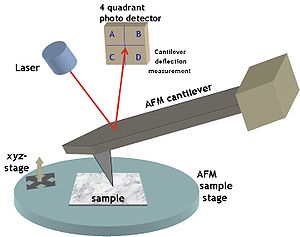
- Image via Wikipedia
Lasers have revolutionized the communications and medical industries.
They focus light to zap tumors and send digital TV signals and telephone communications around the world.
But the physical length of an ordinary laser cannot be less than one half of the wavelength of its light, which limits its application in many industries. Now the Spaser, a new invention developed in part by Tel Aviv University, can be as small as needed to fuel nano-technologies of the future.
Prof. David Bergman of Tel Aviv University’s Department of Physics and Astronomy developed and patented the theory behind the Spaser device in 2003 with Prof. Mark Stockman of Georgia State University in Atlanta. It is now being developed into a practical tool by research teams in the United States and around the world.
“Spaser” is an acronym for “surface plasmon amplification by stimulated emission of radiation” — and despite its mouthfilling definition, it’s a number one buzzword in the nanotechnologies industry. The Spaser has been presented at recent meetings and symposia around the world, including a recent European Optical Society Annual Meeting.
Seeing your DNA up close
Spasers are considered a critical component for future technologies based on nanophotonics — technologies that could lead to radical innovations in medicine and science, such as a sensor and microscope 10 times more powerful than anything used today. A Spaser-based microscope might be so sensitive that it could see genetic base pairs in DNA.
It could also lead to computers and electronics that operate at speeds 100 times greater than today’s devices, using light instead of electrons to communicate and compute. More efficient solar energy collectors in renewable energy are another proposed application.
Related articles
- New materials may bring advanced optical technologies, cloaking (nanotech-now.com)








